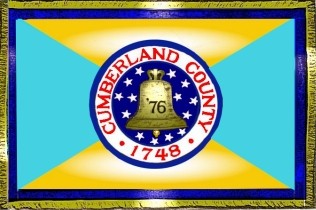Bits of SJ: The Birth of a County
 The Colonial Legislature, at a session held January 30, 1748, passed an Act erecting the east side of Salem County into a new county to be called Cumberland. It was so named by Governor Jonathan Belcher in honor of his patron, William Augustus, Duke of Cumberland, brother of the king and the victor over "Bonnie Prince Charles", (Stuart) the Young Pretender to the throne of England whose hopes were quenched at the bloody Battle of Culloden Moor.
The Colonial Legislature, at a session held January 30, 1748, passed an Act erecting the east side of Salem County into a new county to be called Cumberland. It was so named by Governor Jonathan Belcher in honor of his patron, William Augustus, Duke of Cumberland, brother of the king and the victor over "Bonnie Prince Charles", (Stuart) the Young Pretender to the throne of England whose hopes were quenched at the bloody Battle of Culloden Moor. The Act establishing the new county divided it into six townships: Greenwich, Hopewell, Stow Creek, Deerfield, Fairfield, and Maurice River. The Legislature ordered the Freeholders to meet first at Cohansey Bridge, which is now Bridgeton, to arrange for the taking of a poll to determine the location of the county seat. The first court was held at Greenwich. In December of the same year, 1748, Cohansey Bridge (now Bridgeton) was chosen as the seat of county government. The selection was compromise, Greenwich, Fairfield and Deerfield contending for the honor, the convenience and the practical advantage from a business standpoint.
In 1752, Cumberland County's first court house, (Cumberland has had four) was built in the center of what is now West Broad Street, east of the line of Franklin Street. During the next 15 years, Cumberland County developed rapidly and, at the same time, dissatisfaction over Colonial rule was increasing, a feeling that brought about eventual separation from the British Crown. In 1772, Cumberland first elected two representatives to the Colonial Legislature. Theretofore, Salem and Cumberland had been jointly represented. Downe Township was established. It was given the maiden name of Governor William Franklin's wife, Elizabeth Downes, whose name was misspelled in the printed legislation and has been misspelled ever since.
Patriot sentiment predominated though it was by no means unanimous in Cumberland County. Clear lines began to be drawn after the Boston Tea Party of December 1773. By December of the following year (1774) Greenwich was ready for its own "Tea Party" (its own reaction to British tea). The boxes stored in the town for later shipment to Philadelphia, were seized and burned on Market Square. This was the only act of violence against British authority in New Jersey prior to the Revolution.
Philip Vickers Fithian, Greenwich resident, College of New Jersey graduate, and would-be Presbyterian minister, kept a journal from 1766 to 1776, which narrated those stormy days. He witnessed a similar tea burning in the town of Annapolis, Maryland, though he never admitted being one of the Greenwich tea burners.
During the winter of 1775-1776, after hostilities had begun in Massachusetts, the "Plain Dealer", a hand written news sheet appeared in Potter's Tavern, Bridgeton (pictured at right), submitted by the young lawyers of the county seat. Among the articles of local news and gossip were several stories, serious and comic, which dealt with the choices Americans had to make of loyalty to Britain, adherence to the Patriot cause, or neutrality. Cumberland's pride in its Liberty Bell is reflected in its official flag executed in 1955 from a design unanimously adopted by resolution of the Board of Chosen Freeholders earlier that year. The banner is displayed in the Freeholders Room at the courthouse and is used on ceremonial occasions.
The flag was designed by J. Landis Meade and was adopted as the official insignia by the freeholders in 1955. Cumberland County split from Salem County in 1748, which is represented in the red lettering on the flag. The buff and sky blue of the diagonally quartered primary portion represent the colors of the uniforms worn by the Continental troops in the Revolutionary War. The insignia of a bell in the central portion of deep blue is a likeness of Cumberland's own Liberty Bell. The bell, bearing the date of independence, is surrounded by 14 stars positioned at random, each representing a municipal subdivision in the county at the time.
Information courtesy of Cumberland County, NJ. For more information, visit their website at www.co.cumberland.nj.us.
For more South Jersey History, visit our SJ History page.
advertisement

Author: Editor
Archives
A TALE OF THREE WEDDINGS
Timber Creek’s Leary heads to Illinois
The Berlin Cemetery
A Southern Mansion
Fire on the Morro Castle
Pine Barrens Fire of 1936
The Legacy of Hezekiah Bradley Smith
The Powhatan Renape Indians
The `Park-In` Movie Theatre
Glassboro: A History
New Jersey Natives: The Lenni-Lenape
Burlington County Prison Museum
Parvin State Park
Haines Mill
John Henry `Pop` Lloyd
More...







